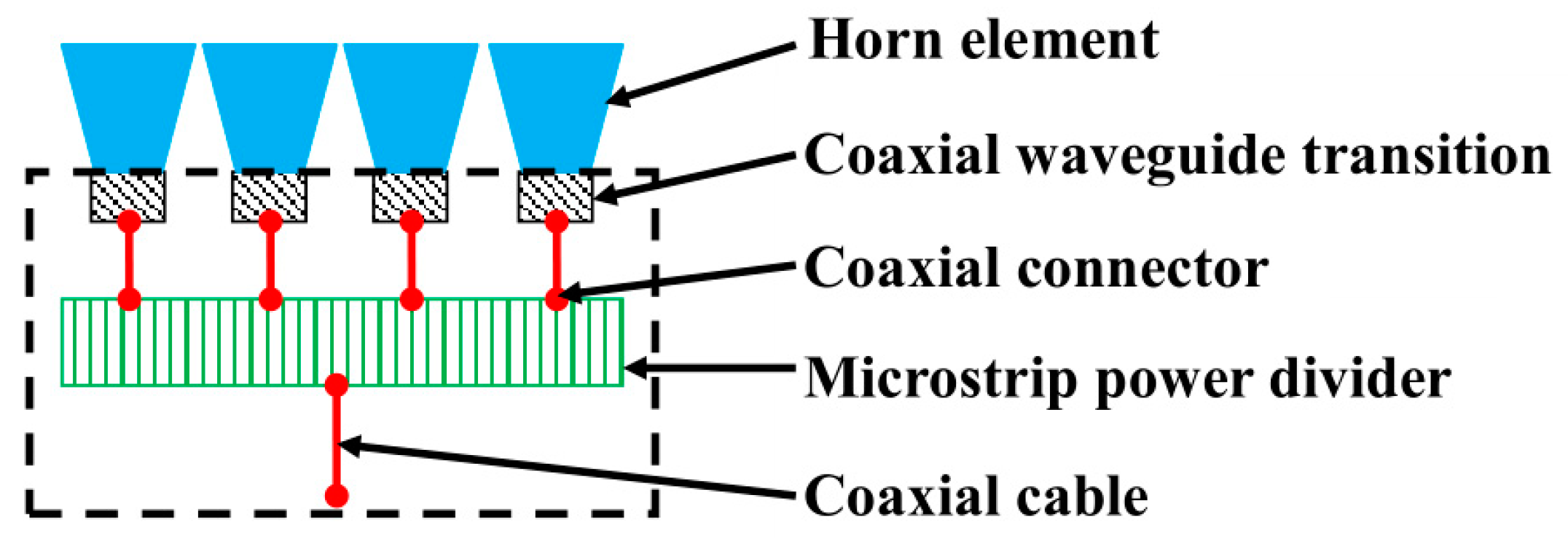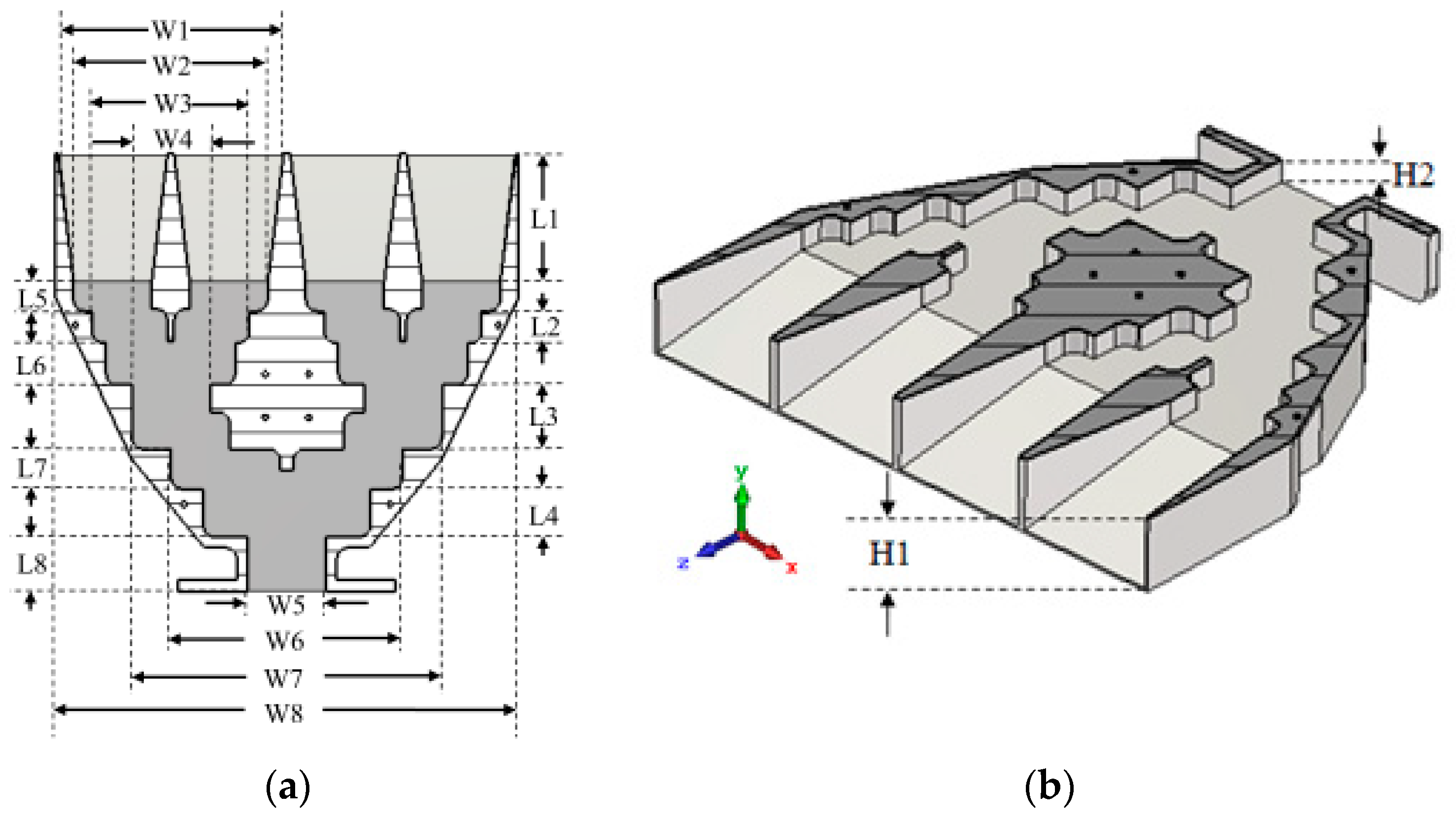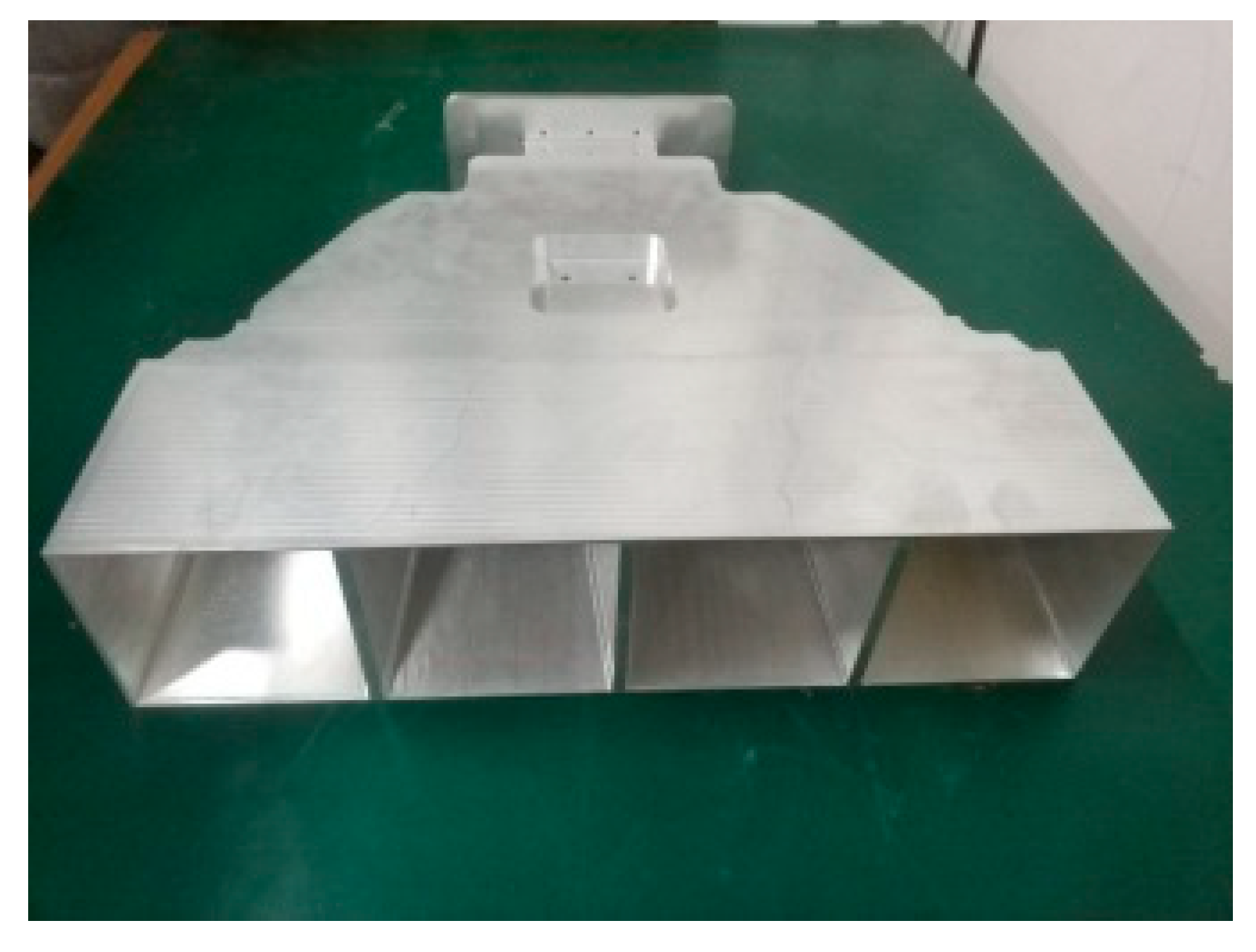A High Channel Consistency Subarray of Plane-Wave Generators for 5G Base Station OTA Testing
Abstract
:1. Introduction
2. Theory and Error Analysis of the Subarray
2.1. Design Theory of the Subarray
2.2. The Error Analysis of Subarray
3. Theoretical Analysis and Design of the Power Dividing Horn Subarray
3.1. Traditional Y-Junction Structure
3.2. The Design of Power Dividing Horn Subarray
4. Simulation and Measurement Results
5. Conclusions
Author Contributions
Funding
Conflicts of Interest
References
- Dahlman, E.; Mildh, G.; Parkvall, S.; Peisa, J.; Sachs, J.; Selén, Y.; Sköld, J. 5G wireless access: Requirements and realization. IEEE Commun. Mag. 2014, 52, 42–47. [Google Scholar] [CrossRef]
- Li, Q.; Wei, Y.Y.; Tan, M.T.; Lei, X.; Wu, G.X.; Huang, M.Z.; Gong, Y.B. Flexibly Extensible Planar Self-Isolated Wideband MIMO Antenna for 5G Communications. Electronics 2019, 8, 994. [Google Scholar] [CrossRef]
- Siddiqi, M.A.; Yu, H.; Joung, J. 5G Ultra-Reliable Low-Latency Communication Implementation Challenges and Operational Issues with IoT Devices. Electronics 2019, 8, 981. [Google Scholar] [CrossRef]
- Bangash, K.; Khan, I.; Lloret, J.; Leon, A. A Joint Approach for Low-Complexity Channel Estimation in 5G Massive MIMO Systems. Electronics 2018, 7, 218. [Google Scholar] [CrossRef]
- Hassan, N.; Fernando, X. Massive MIMO Wireless Networks: An Overview. Electronics 2017, 6, 63. [Google Scholar] [CrossRef]
- Li, Y.; Wang, C.T.; Yuan, H.W.; Liu, N.; Zhao, H.L.; Li, X.L. A 5G MIMO Antenna Manufactured by 3-D Printing Method. IEEE Antennas Wirel. Propag. Lett. 2016, 16, 657–660. [Google Scholar] [CrossRef]
- Li, Y.; Xin, L.J.; Zhang, X. On Probe Weighting for Massive MIMO OTA Testing Based on Angular Spectrum Similarity. IEEE Antennas Wirel. Propag. Lett. 2019, 18, 1497–1501. [Google Scholar] [CrossRef]
- Qiao, Z.L.; Wang, Z.P.; Loh, T.H.; Gao, S.; Miao, J.G. A Compact Minimally Invasive Antenna for OTA Testing. IEEE Antennas Wirel. Propag. Lett. 2019, 18, 1381–1385. [Google Scholar] [CrossRef]
- Kyösti, P.; Fan, W.; Pedersen, G.F.; Latva-Aho, M. On Dimensions of OTA Setups for Massive MIMO Base Stations Radiated Testing. IEEE Access 2016, 4, 5971–5981. [Google Scholar] [CrossRef]
- Reed, D.; Rodriguez-Herrera, A.; Borsato, R. Measuring massive MIMO array systems using over the air techniques. In Proceedings of the 2017 11th European Conference on Antennas and Propagation (EUCAP), Paris, France, 19–24 March 2017; pp. 3663–3667. [Google Scholar]
- Fan, W.; Carton, I.; Kyösti, P.; Karstensen, A.; Jämsä, T.; Gustafsson, M.; Pedersen, G.F. A Step Toward 5G in 2020: Low-cost OTA performance evaluation of massive MIMO base stations. IEEE Antennas Propag. Mag. 2017, 59, 38–47. [Google Scholar] [CrossRef]
- Gillespie, E.S.; Hess, D.W.; Stubenrauch, C.F. Antenna measurements: A comparison of far-field, compact range and near-field techniques. In Proceedings of the Conference on Precision Electromagnetic Measurements Digest, Boulder, CO, USA, 27 June–1 July 1994; p. 375. [Google Scholar]
- Bucci, O.M.; Migliore, M.D.; Panariello, D.; Pinchera, D. Plane-Wave Generators: Design Guidelines, Achievable Performances and Effective Synthesis. IEEE Trans. Antennas Propag. 2013, 61, 2005–2018. [Google Scholar] [CrossRef]
- Zhang, X.H.; Zhang, Z.H.; Ma, Y.J. 5G Antenna system OTA testing with plane wave generator in range-constrained anechoic chamber. In Proceedings of the 2017 Sixth Asia-Pacific Conference on Antennas and Propagation (APCAP), Xi’an, China, 16–19 October 2017; pp. 1–3. [Google Scholar]
- Poordaraee, M.; Glazunov, A.A. Plane wave synthesis with irregular chamber planar antenna arrays for Compact OTA Measurements. In Proceedings of the 2019 13th European Conference on Antennas and propagation (EuCAP), Krakow, Poland, 31 March–5 April 2019; pp. 1–5. [Google Scholar]
- Wang, H.; Miao, J.G.; Jiang, J.S. A near-field planar array of pyramidal horn antennas for plane-wave synthesis. In Proceedings of the 2010 IEEE International Conference on Ultra-Wideband, Nanjing, China, 20–23 September 2010; pp. 1–4. [Google Scholar]
- Scattone, F.; Sekuljica, D.; Giacomini, A.; Saccardi, F.; Scannavini, A.; Gross, N.; Kaverine, E.; Iversen, P.O.; Foged, L.J. Design of dual polarised wide band plane wave generator for direct far-field testing. In Proceedings of the 13th European Conference on Antennas and Propagation (EuCAP), Krakow, Poland, 31 March–5 April 2019; pp. 1–4. [Google Scholar]
- Tsunemitsu, Y.; Matsumoto, S.; Kazama, Y.; Hirokawa, J.; Ando, M. Reduction of Aperture Blockage in the Center-Feed Alternating-Phase Fed Single-Layer Slotted Waveguide Array Antenna by E-to H-Plane Cross-Junction Power Dividers. IEEE Trans. Antennas Propag. 2008, 56, 1787–1790. [Google Scholar] [CrossRef]
- Deng, J.; Wang, Q.Y.; Zhao, P.; Tian, M.J.; Li, Q.S. A Quasi-Planar H-Plane Waveguide Power Divider with Full Bandwidth. IEEE Microw. Wirel. Compon. Lett. 2018, 28, 645–647. [Google Scholar] [CrossRef]
- Sun, X.L.; Wang, Z.P.; Miao, J.G. Near Field Quasi Plane Wave Generation and Performance Evaluation. In Proceedings of the 2018 Asia-Pacific Microwave Conference (APMC), Kyoto, Japan, 6–9 November 2017; pp. 917–919. [Google Scholar]
- Xie, R.S.; Wang, X.; Wang, R.W.; Wang, T.L.; Chen, D.; Song, T.; Zhu, K.S. Synthesis of plane wave applied to 5G communication antenna measurement. In Proceedings of the 2017 Progress in Electromagnetics Research Symposium—Spring (PIERS), St. Petersburg, Russia, 22–25 May 2017; pp. 195–198. [Google Scholar]
- Brockett, T.J.; Rahmat-Samii, Y. Subarray Design Diagnostics for the Suppression of Undesirable Grating Lobes. IEEE Trans. Antennas Propag. 2012, 60, 1373–1380. [Google Scholar] [CrossRef]
- Sehm, T.; Lehto, A.; Raisanen, A.V. A large planar 39-GHz antenna array of waveguide-fed horns. IEEE Trans. Antennas Propag. 1998, 46, 1189–1193. [Google Scholar] [CrossRef]
- Ding, Y.; Wu, K. T-Type Folded Substrate Integrated Waveguide (TFSIW) Slot Array Antenna. IEEE Trans. Antennas Propag. 2010, 58, 1792–1795. [Google Scholar] [CrossRef]
- Li, T.; Chen, Z.N. A Dual-Band Metasurface Antenna Using Characteristic Mode Analysis. IEEE Trans. Antennas Propag. 2018, 66, 5620–5624. [Google Scholar] [CrossRef]













| Case | Amplitude Error (dB) | Phase Error (°) | Observation Position in z-axis (m) | ||||||
|---|---|---|---|---|---|---|---|---|---|
| E1 | E2 | E3 | E4 | E1 | E2 | E3 | E4 | ||
| 1 | 0 | 0 | 0 | 0 | 0 | 0 | 0 | 0 | 2 |
| 2 | 0.92 | 0 | 0.72 | 0.45 | 0 | 5 | 20 | 13 | 2 |
| 3 | 0.92 | 0 | 0.72 | 0.45 | 0 | 0 | 0 | 0 | 2 |
| 4 | 0 | 0 | 0 | 0 | 0 | 5 | 20 | 13 | 2 |
| 5 | 0 | 0 | 0 | 0 | 0 | 5 | 15 | 20 | 2 |
| 6 | 0 | 0 | 0 | 0 | 0 | 20 | 20 | 0 | 2 |
| 7 | 0 | 0 | 0 | 0 | 20 | 0 | 0 | 20 | 2 |
| 8 | 0 | 0 | 0 | 0 | 0 | 20 | 0 | 20 | 2 |
| 9 | 0 | 0 | 0 | 0 | 0 | 19 | 6 | 15 | 2 |
| 10 | 0 | 0 | 0 | 0 | 0 | 0 | 0 | 0 | 1 |
| 11 | 0 | 0 | 0 | 0 | 20 | 0 | 0 | 20 | 1 |
| 12 | 0 | 0 | 0 | 0 | 0 | 0 | 0 | 0 | 1.5 |
| 13 | 0 | 0 | 0 | 0 | 20 | 0 | 0 | 20 | 1.5 |
| Parameters | mm | Parameters | mm |
|---|---|---|---|
| W1 | 208.28 | L2 | 29.5 |
| W2 | 179.28 | L3 | 59 |
| W3 | 145.28 | L4 | 44 |
| W4 | 72.14 | L5 | 27 |
| W5 | 72.14 | L6 | 38.5 |
| W6 | 213.42 | L7 | 37 |
| W7 | 286.42 | L8 | 50 |
| W8 | 426.56 | H1 | 52.55 |
| L1 | 118 | H2 | 17.02 |
© 2019 by the authors. Licensee MDPI, Basel, Switzerland. This article is an open access article distributed under the terms and conditions of the Creative Commons Attribution (CC BY) license (http://creativecommons.org/licenses/by/4.0/).
Share and Cite
Qiao, Z.; Wang, Z.; Miao, J. A High Channel Consistency Subarray of Plane-Wave Generators for 5G Base Station OTA Testing. Electronics 2019, 8, 1148. https://doi.org/10.3390/electronics8101148
Qiao Z, Wang Z, Miao J. A High Channel Consistency Subarray of Plane-Wave Generators for 5G Base Station OTA Testing. Electronics. 2019; 8(10):1148. https://doi.org/10.3390/electronics8101148
Chicago/Turabian StyleQiao, Zhaolong, Zhengpeng Wang, and Jungang Miao. 2019. "A High Channel Consistency Subarray of Plane-Wave Generators for 5G Base Station OTA Testing" Electronics 8, no. 10: 1148. https://doi.org/10.3390/electronics8101148





